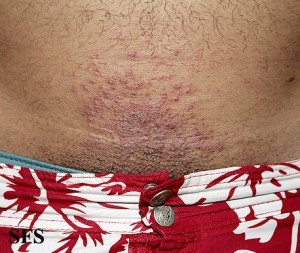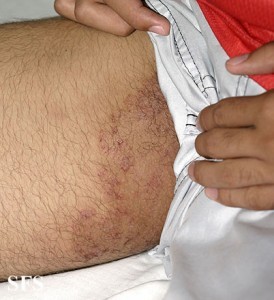Dark Skin Around The Waist (Hyperpigmentation) Causes
The color of human skin is not uniform throughout the body. There are variations which are more visible on some areas and on some people more than others. For example, we often except that our face and hands will often be a slightly different color from chest or abdomen in most people since one area is more exposed to the sun than the others.
Sun exposure is one of the many factors that increases melanin production, and melanin is the natural pigment that is responsible for skin color. When one area become much darker than the rest, especially if it is not an area that is specifically exposed to the sun compared to the rest of the body, then it is important to identify the cause of this darkening.
Reasons for Waist Hyperpigmentation
The medical term for darkening of the skin is hyperpigmentation. It can be localized when it occurs only in specific areas, or generalized when it affects the entire body. Hyperpigmentation simply means that the pigmentation in the affected area increases due to a rise in melanin production (melanogenesis).
While there are a number of reasons why pigmentation may occur physiologically, like with sun exposure, the waist is usually not an area that is exposed like the face or hands. Darkening that is localized to the waist and sometimes surrounding areas is usually not considered as normal especially if it occurs relatively suddenly and is accompanied by other symptoms like itching or roughness.
Melanin is produced by melanocytes (melanin-producing cells). This brown pigment is present in every person’s skin irrespective of their ethnicity. Lighter complexions have less melanin production while darker complexions have more. There are other factors that determine skin color like the blood vessels in the skin that give a red tinge to the naturally brown color.
Melanin production is due to genetic factors but every melanocyte has the capability to produce more or less pigment based on certain control factors. Hormones, certain vitamin byproducts, mechanical irritation, chemical damage, UV light exposure and toxins, among other factors can cause localized hyperpigmentation.
Causes of Darkening Around the Waist
There are a number of causes of darkening of the skin around the waist. Some of the contributing factors are relatively unique to the area while other factors may be common causes for skin darkening anywhere on the body. Although sexually transmitted diseases that cause skin eruptions have not been discussed below, it should be considered as a possible cause.
Persistent irritation, severe inflammation or long term skin problems in the waist area are more likely to lead to darkening. Darkening from prolonged inflammation is known as postinflammatory hyperpigmentation. Chronic skin problems are more likely to lead to permanent darkening.
Mechanical Trauma
The two main causes of recurrent or persistent mechanical trauma is the friction created by clothing on the skin or by folds of skin rubbing against each other. The first type of chaffing may be due to tight underwear or garments made of rough textiles. A very tight belt can also cause the clothing to press against the skin and result in chaffing.
The second type is usually seen in overweight or obese people, particularly where there is abdominal obesity. The folds are due to fat and persistent rubbing together will lead to darkening. Chaffing may lead to inflammation of the skin (intertrigo) and breaks in the skin may occur. This increases the chance of fungal and bacteria infections.
Allergic Reaction
An allergic reaction isolate to the waist area is more likely due to textiles that comes into contact with the skin. It may be the clothing or undergarments. Allergies are a result of the immune system overreacting to harmless substances. Textiles are not the only potential allergens.
The constituents of soaps and body lotions are also a possible cause depending on individual sensitivity. When an allergic reaction arises from contact with an allergen, then this is known as allergic contact dermatitis. Eventually the persistent inflammation can lead to darkening. Metal allergies, as is the case with nickel, may also be a cause if jewelry is worn around the waist and makes direct skin contact.
Irritant Dermatitis
Irritant contact dermatitis causes a similar skin problem as allergic contact dermatitis. The difference is that the substances that irritates the skin does not cause an allergic reaction. In other words it is an irritant, not an allergen. Irritants may vary from textiles and skin care products, to sweat, soap and even water.
Usually the irritant is exposed to the skin for long periods of time and would otherwise not usually pose a problem during short term exposure. As with other causes, the repeated irritation of the skin would contribute to inflammation and eventually may lead to darkening of the skin.

Skin Infections
Skin infections caused by fungi, bacteria or viruses can also lead to darkening. It largely depends on the severity of skin inflammation at the site of the infection, as well as the duration of the infection. More severe infections or longer-lasting infections are more likely to cause darkening of the skin.
Fungal infections of the skin (ringworm) caused by dermatophytes are the most likely chronic skin infection around the waist area. It can persist for months or even years and gradually leads to darkening of the affected area. Viral infections are usually acute, except for shingles. Bacterial infections are also acute but usually severe and need prompt treatment.

Inflammatory Skin Diseases
Any inflammatory skin disease will eventually lead to darkening of the skin over time. This may include skin diseases such as atopic dermatitis (eczema), psoriasis and drug skin eruptions to name but a few. Apart from inflammation, excessive skin dryness can also make it prone to darkening, whether this dryness is related to an inflammatory skin disease or not. Therefore inflammatory skin diseases should be treated promptly and appropriately to prevent long term complications like darkening that may not resolve.
Other Causes
- Stretch marks (usually causes pale to white streaks rather than darkening).
- Acanthosis nigricans (dark and thick skin but usually not waist)
- Skin cancers like a melanoma (the waist is an uncommon area)
- Benign growths like melanocytic nevi (moles) and lentigos.
Last updated on October 10, 2018.






